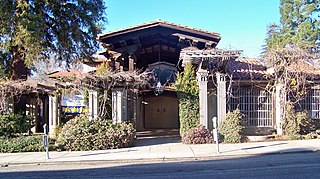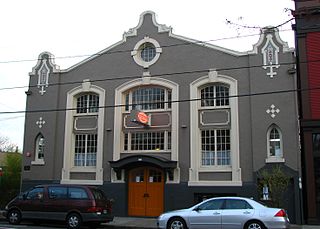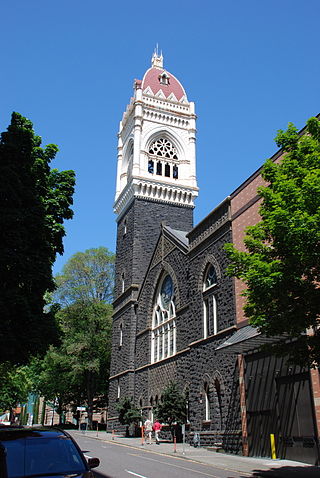
First Church of Christ, Scientist, Berkeley, now also known as Christian Science Society, Berkeley, is a Christian Science church, located at 2619 Dwight Way at Bowditch Street across the street from People's Park, in Berkeley, in Alameda County, California.

The former First Church of Christ, Scientist in Forest Grove, Oregon, United States, is a historic Christian Science church built in 1916. It was designed by Spencer S. Beman, son of the noted designer of Christian Science churches, Solon Spencer Beman who had died in 1914. On January 21, 1994, it was added to the National Register of Historic Places.

The former First Church of Christ, Scientist is an historic Christian Science church building located at 1200 North Robinson Avenue in Oklahoma City, Oklahoma, United States. Built in 1920, it was designed in the Classical Revival style of architecture. On September 9, 2001, was added to the National Register of Historic Places.

The former First Church of Christ, Scientist, located at 2200 Overlook Road, in the University Circle area of Cleveland, Ohio, in the United States is an historic building that was added to the National Register of Historic Places on February 20, 2003.

The former First Church of Christ, Scientist, built in 1912, is a historic Christian Science church edifice located at 1366 South Alvarado Street in Pico-Union, Los Angeles, California.

First Church of Christ, Scientist, built in 1901, is an historic Mission Revival-style Christian Science church located at 3606 Lemon Street in Riverside, California. It has been called: "the church that introduced Christian Science to Southern California." It was designed by noted Los Angeles architect Arthur Burnett Benton. On September 22, 1992, First Church of Christ, Scientist, was added to the National Register of Historic Places. It is still listed in the Christian Science Journal as an active Christian Science church.

Third Church of Christ, Scientist, established in 1918, is a Christian Science church in downtown Washington, D.C. From 1971 to 2014, the church was located in a controversial building at 16th and I Street NW. Considered a significant work of "Brutalist" church architecture by some critics, the building was considered unsatisfactory by members of the Church's congregation, which shrank over the years. In 2007, the church applied for a demolition permit for the building to permit sale and redevelopment of the site, with plans to relocate to a more suitable structure. A 1991 application for landmark status for the building, filed to forestall a demolition threat then, was subsequently approved. After a lawsuit and hearings, the District of Columbia issued a demolition permit in May 2009, and the building was demolished in 2014. In 2015, Third Church merged with First Church of Christ, Scientist. The congregation continues as First Church and conducts its activities in a portion of the new building.

The former First Church of Christ, Scientist, is an historic Christian Science church building located at 700 22nd Street, Rock Island, Illinois, United States. Designed by architect William C. Jones of Chicago in the Palladian style, it was built between 1914-1915. Its exterior walls are of brick covered by Bedford limestone. Its superimposed front portico is supported by six 2 story columns with egg-and-dart capitals. Its dome actually consists of 2 domes: an outer dome and an inner dome which are separated by a space for lighting fixtures and maintenance. The inner dome consists of some 8,000 colored fish scale glass panes on a wooden support structure. The inner dome is similar to the inner dome of First Church of Christ, Scientist in Kalamazoo, Michigan, which was designed by William C. Jones in 1913.

Morris Homans Whitehouse was an American architect whose work included the design of the Gus Solomon United States Courthouse in Portland, Oregon.

The Wonder Ballroom is a music venue located in northeast Portland, Oregon. Prior to opening in 2004, the building was occupied by the Ancient Order of Hibernians, the Catholic Youth Organization, the Portland Boxing School, the American Legion organization, and a community center eventually known as the Collins Center. In 2005, the building was listed on the National Register of Historic Places as the Hibernian Hall for its "historic and architectural significance".

The Harlow Block, also known as the Hayhurst Building, is a historic building located in Portland, Oregon, United States, built in 1882. It is listed on the National Register of Historic Places.

The First Congregational Church is a church located in downtown Portland, Oregon, listed on the National Register of Historic Places. Construction took place over a period of six years, from 1889 to 1895. The building was designed by Swiss architect Henry J. Hefty in Venetian Gothic style. The interior includes stained-glass windows, commissioned in 1906, made by Portland's Povey Brothers Studio. The building's height to the top of the bell tower is 175 feet to 185 feet.

The First Unitarian Church of Portland is a church building located in downtown Portland, Oregon, listed on the National Register of Historic Places. Located on S.W. 12th Avenue at Salmon Street, it was constructed and opened in 1924.

The M. Lloyd Frank Estate, also known as the Frank Manor House, is an historic building on campus of Lewis & Clark College, in Portland, Oregon, United States. It is listed on the National Register of Historic Places.

The Campbell Hotel, located in northwest Portland, Oregon, is a historic former residential hotel that is listed on the National Register of Historic Places (NRHP). It is now an apartment building named the Campbell Court Apartments.

The Honeyman Hardware Company Building is a historic commercial building located at 832 NW Hoyt Street in Northwest Portland, Oregon. It was completed in 1912 and was listed on the National Register of Historic Places on December 15, 1989.

Povey Brothers Studio, also known as Povey Brothers Art Glass Works or Povey Bros. Glass Co., was an American producer of stained glass windows based in Portland, Oregon. The studio was active from 1888 to 1928. As the largest and best known art glass company in Oregon, it produced windows for homes, churches, and commercial buildings throughout the West. When the firm was founded in 1888, it was the only creative window firm in Portland, then a city of 42,000 residents.






















